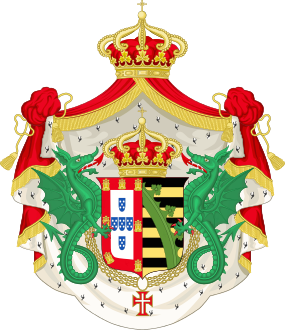Vương tộc Bragança-Saxe-Coburgo-Gota
Vương tộc Bragança-Saxe-Coburgo-Gota (còn được gọi là Nhà Sachsen-Coburg-Bragança hoặc Chi nhánh Hiến pháp của Braganças)[1] là một thuật ngữ được sử dụng để phân loại bốn vương tộc cai trị cuối cùng của Vương quốc Bồ Đào Nha, từ năm 1853 cho đến khi Bồ Đào Nha trơ thành một nhà nước cộng hoà vào năm 1910. Tên vương tộc bắt nguồn từ 4 vị vua thuộc dòng dõi từ dòng dõi nữ từ Nữ vương Maria II của Bồ Đào Nha (của Nhà Bragança) và dòng dõi nam từ Vua Fernando II của Bồ Đào Nha (của Nhà Sachsen-Coburg và Gotha-Koháry).
 | |
| Quốc gia | |
|---|---|
| Hoàng tộc cũ | |
| Danh hiệu | Danh sách
|
| Người cuối cùng | Manuel II |
| Sáng lập | 9 April 1836 |
| Giải thể | 2 July 1932 (Manuel II qua đời) |
| Phế truất | Ngày 5/10/1910 |
| Dân tộc | Người Bồ Đào Nha |
Tên gọi Bragança-Saxe-Coburgo-Gota chủ yếu phổ biến trong các tác phẩm của các nhà sử học và gia phả nằm ngoài Bồ Đào Nha, vì theo phong tục châu Âu phân loại một nhánh hậu duệ trên cơ sở huyết thống, có nghĩa là Nhà Bragança-Saxe-Coburgo-Gota là một chi nhánh của Nhà Sachsen-Coburg và Gotha-Koháry.
Tuy nhiên, Hiến pháp Bồ Đào Nha năm 1838 tuyên bố rằng Nhà Bragança là nhà cai trị của Bồ Đào Nha, theo cách của Nữ vương Maria II, và con cháu của bà vẫn tiếp tục là thành viên của Nhà Bragança, trái ngược với Sachsen-Coburg-Bragança.[2] Sau cái chết của Vua Manuel II mà không có người thừa kế vào năm 1932, vương triều tuyệt tự.[3]
Lịch sử sửa
Nhà cai trị sửa
Cây phả hệ sửa
Tham khảo sửa
| Wikimedia Commons có thêm hình ảnh và phương tiện truyền tải về Vương tộc Bragança-Saxe-Coburgo-Gota. |
- ^ Maclagan, Michael (2002). Lines of Succession. Tables by Jiri Louda. Time Warner Books. tr. 187. ISBN 0-316-72428-9.
- ^ CONSTITUIÇÃO POLITICA DA MONARCHIA PORTUGUEZA p. Title 1, Chapter 1, Article 5.
- ^ Almanach de Gotha (ấn bản 175). Justus Perthes. 1938. tr. 112.
Đọc thêm sửa
- PINTO, Albano Anthero da Silveira; VISCONDE, Augusto Romano Sanches de Baêna e Farinha; Resenha das familías titulares e grandes de Portugal (Volume 1). Lisboa: Empreza Editora de Francisco Arthur da Silva (1883). Pág. 313
- McCULLOCH, John Ramsay; A Dictionary, Geographical, Statistical, and Historical: of the various Countries, Places, and Principal Natural Objects in the World (Volume 4). Longmans: Green (1866). Pág. 14
- Almanach de Gotha. Justus Perthes Publishing House in Gotha; 175th ed.
- American Annals of Education (Volume 18). Otis: Broaders (1869).
- ROBINSON, James Harvey; BEARD, Charles Austin; The development of modern Europe: an introduction to the study of current history. Ginn & Company (1908). Pág. 27.
- The British Almanac: Containing Astronomical, Official and Other Information Relating to the British Isles, the Dominions Oversea and Foreign Countries. Stationers Company (1909). Pág. 457
- W.H. De Puy; The Century Reference Library of Universal Knowledge (Volume 8). National Newspapers Company (1909).
- ROLT-WHEELER, Francis; DRINKER, Frederick E.; The World War for Liberty: A Comprehensive and Authentic History of the War by Land, Sea and Air. C.H. Robinson Company (1919). Pág. 382
- COLENBRANDER, Herman Theodoor; deel. Algemeene koloniale geschiedenis. M. Nijhoff (1925). Pág. 26.
- Current History (Volume 38). New York Times Company (1933). Pág. 239.
- The Catholic Encyclopedia: Laprade-Mass. Appleton (1950). Pág. 282.
- FRANCIS, John Michael (Editor); Iberia and the Americas: Culture, Politics, and History (Transatlantic Relations), 3 Volumes Set. ABC-CLIO (November 21, 2005). Págs. 724 e 1112.
- OLIVEIRA, Barradas de; Quando os cravos murcham (Volume 2). Edições FP (1984). Pág. 41.
- FIGUEIREDO, Fidelino de; Revista de História (Volumes 10-11). Emprêsa Literária Fluminense (1921). Pág. 220.
- PAILLER, Jean; Maria Pia of Braganza: The Pretender. New York: ProjectedLetters, 2006;
- CHILCOTE, Ronald H.; The Portuguese Revolution: State and Class in the Transition to Democracy, page 37. Rowman & Littlefield Publishers; Reprint edition (August 31, 2012).